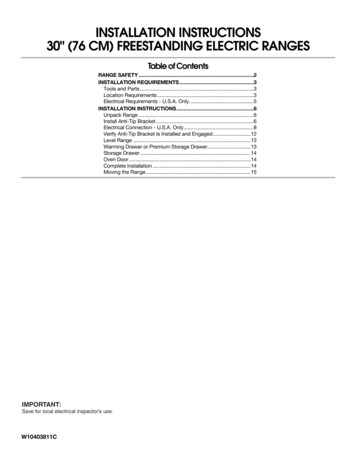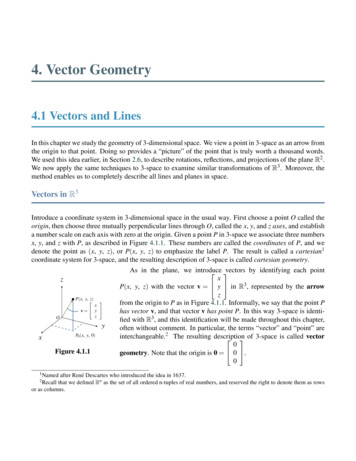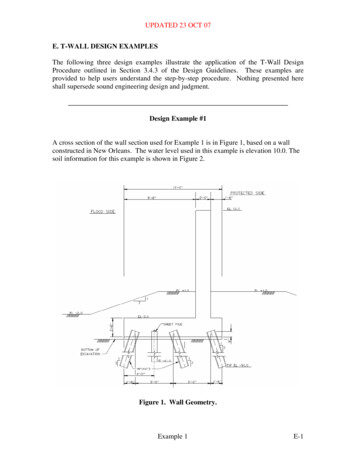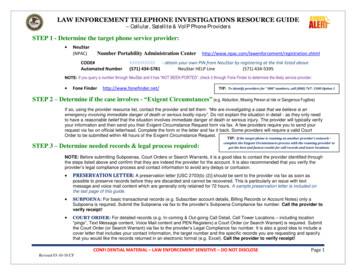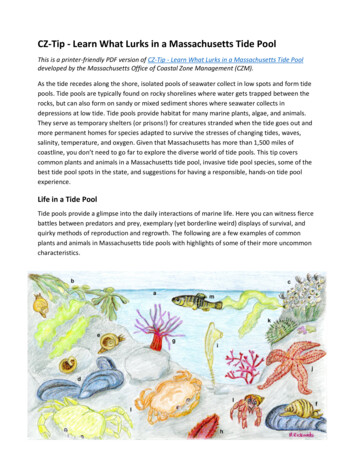
Transcription
CZ-Tip - Learn What Lurks in a Massachusetts Tide PoolThis is a printer-friendly PDF version of CZ-Tip - Learn What Lurks in a Massachusetts Tide Pooldeveloped by the Massachusetts Office of Coastal Zone Management (CZM).As the tide recedes along the shore, isolated pools of seawater collect in low spots and form tidepools. Tide pools are typically found on rocky shorelines where water gets trapped between therocks, but can also form on sandy or mixed sediment shores where seawater collects indepressions at low tide. Tide pools provide habitat for many marine plants, algae, and animals.They serve as temporary shelters (or prisons!) for creatures stranded when the tide goes out andmore permanent homes for species adapted to survive the stresses of changing tides, waves,salinity, temperature, and oxygen. Given that Massachusetts has more than 1,500 miles ofcoastline, you don’t need to go far to explore the diverse world of tide pools. This tip coverscommon plants and animals in a Massachusetts tide pool, invasive tide pool species, some of thebest tide pool spots in the state, and suggestions for having a responsible, hands-on tide poolexperience.Life in a Tide PoolTide pools provide a glimpse into the daily interactions of marine life. Here you can witness fiercebattles between predators and prey, exemplary (yet borderline weird) displays of survival, andquirky methods of reproduction and regrowth. The following are a few examples of commonplants and animals in Massachusetts tide pools with highlights of some of their more uncommoncharacteristics.1
The species links below are to the following sources: CZM’s Marine Invasive Species ID Cards (crabs), Woods Hole OceanographicInstitution’s Life in a Massachusetts Tide Pool website (barnacles, sea cucumbers, sea squirts, sea stars, and sea urchins); NationalGeographic's Resource Library (plankton and sea anemone); and Encyclopedia of Life (bladder wrack, periwinkles, dogwinkles,mummichogs, and mussels). All photos are by CZM unless otherwise noted.a Plankton - Named for the Greek word for “drifter” or“wanderer,” plankton are the tiny plants and animals thatfloat in the ocean with the currents. The tiny plants are calledphytoplankton and they produce their own food throughphotosynthesis, a process that also releases oxygen into theair (it is estimated that 80% of the oxygen on Earth isproduced by phytoplankton). The tiny animals are thezooplankton, some of which remain zooplankton all their lifewhile others grow to become strong-swimming, nonplankton adults. (Fun fact: There can be 50,000 plankton in agallon of sea water.)b Bladder Wrack and Other Seaweeds and Algae - Bladderwrack and knotted wrack, two common seaweeds in a tidepool, use air bladders to float when the tide is in (giving themaccess to sunlight and creating a forest under the water) andthen lay flat on the rocks when the tide is out, forming a thickcover for other species. Sea lettuce is the green alga that hasbright green silky sheets and ruffled margins. Irish moss (thesmall reddish-purple, fan-shaped seaweed) and other speciesof red algae are abundant where they can be submerged formost of the day. (Fun fact: Simple seaweeds may have beenthe Earth’s first plants.)c Barnacles - When barnacles are young, they are freeswimmers and resemble tiny shrimp. Once they find anappropriate place to settle down, they glue their heads to arock and begin the process of building their shells. Theresult—pointed shells with doors that click open and shut(and that are known for their scrape-inducing characteristicson unprotected skin). When the barnacles open, featherylegs extend out of the shells and sift the water for food,namely plankton. (Fun fact: The adhesive property of theglue that barnacles make to attach to rocks is beingresearched for use in dental work.)2Photo: Wikimedia Commons
d Blue Mussels - Also known as the common mussel, theseedible mollusks typically live between the high-tide andlow-tide line, often just beneath the knotted wrack andbladder wrack. They have a slender foot for temporarilyholding themselves in place but use their tough byssalthreads to more permanently adhere to the rocks. Byspinning and cutting these threads, mussels can also usethem to move. (Fun fact: To avoid being eaten, mussels canuse their byssal threads to tether and immobilize predatorslike the dog whelk.)e Periwinkles - These are the snails that you find peacefullygrazing on seaweed and other plants. Periwinkles moveslowly on one foot and scrape up food with a coiled tongue.When the periwinkle pulls itself into its shell, it will close alittle trap door called an operculum. (Not-so-fun fact: Thecommon periwinkle, a non-native invasive species, has outcompeted some native species, altered the distribution andabundance of algae on rocky shores, and even convertedsoft-sediment habitats to hard substrates by preventing theaccumulation of sediment and algal cover.)f Dogwinkles/Dog Whelks - Though similar to periwinkles,these somewhat longer, pointier, and whorled sea snails areferocious carnivorous. They feed on periwinkles, mussels,barnacles, and clams by grinding a round hole right throughthe shells with their drill-like tongues and sucking out theanimal inside. (Fun fact: The color of the New England dogwhelk depends on what it eats—those that consume musselsare dark reddish-brown and those that eat barnacles arewhite or yellowish-brown.)g Sea Anemones - The sea anemone may look harmless, but itis a fierce predator. The petal-like arms or tentacles on thisanimal contain stinging capsules that paralyze prey, such asshrimp and sea stars. When alarmed, the anemone will pullthe tentacles in and shrink down to a small blob. Theanemones that are common to Massachusetts do not haveenough stinging power to harm humans. (Fun fact: A seaslug is the only animal that can eat the stinging tentacles ofthe anemone.)3Photo: Martin Talbot, Wikimedia Commons
h Sea Cucumbers - Even though they are named after avegetable, sea cucumbers are animals. The tube feet thatcover their body are used to attach themselves to rocks andother surfaces, and the modified tube feet around theirmouth are used to capture food such as zooplankton. Themost common sea cucumber in New England is the orangefooted, which grows up to 12 inches long. (Fun fact: Driedsea cucumbers are considered a delicacy in Asia.)Photo: Woods Hole, U.S. Geological Surveyi Sea Squirts/Tunicates - True to their name, these sac-likeanimals pump water in and out of their bodies—filteringfood, expunging wastes, and “squirting” water. (Fun fact:These animals have a spine and brain—at least in the larvalstage when the animal swims freely and resembles atadpole. The larvae eventually attach themselves to hardsurfaces with adhesive organs and begin transforming intofull grown sea squirts. This process involves absorbing thebrain, nerve cord, and tail that they no longer need.)j Sea Stars (aka Starfish) - It is easy to recognize sea stars withtheir spiny skin and star-like shape (typically with five arms,though some species have more). Each of these armscontains an eye that is sensitive to light. The tube feet on theunderside of the sea star help the animal move and feed. Thesea star has the ability to pry apart two halves of a musselshell, push its stomach out its mouth and into the mollusk todigest the animal, and then pull its stomach and the musselcontents back in! (Fun fact: Not only can a sea star regrow alost arm, but an arm can regrow the sea star body.)k Sea Urchins - Often found submerged in the deeper parts ofthe tide pool, sea urchins are noted for their long spines,which help fend off predators. Under the spines lies a hardouter body and tubed feet that help the animal move. Whenthe urchin dies, the spines fall off. Sea urchins use theirbeak-like mouth to voraciously feed on kelp, though theywill also feed on plankton, periwinkles, and even barnaclesand mussels. (Fun fact: Sea urchins will react immediately ifsomething touches them by pointing all of their spinestowards the area of provocation.)4Photo: Becca ToppinPhoto: NOAA Photo Library
l Crabs (PDF, 3 MB) - The most common crab in New Englandis the non-native green crab, an invasive species that lives increvices in the rocks, in kelp, or under submerged rocks. TheAsian shore mcrab, another invasive and voracious predator,competes with the green crab and native crabs for habitat.The native rock and jonah crabs can often be found underrocks deep in a tide pool. Spider crabs may occasionally befound in a tide pool—they are the ones camouflagingthemselves with algae. Hermit crabs, which have no hardexoskeleton and actually look like tiny lobsters with a hooklike abdomen, inhabit discarded periwinkle shells forprotection. (Fun fact: Crabs can re-grow missing legs and claws.)m Mummichogs and Other Fish - Small fish, such asmummichogs (also known as killifish or salt waterminnows), tautogs, blennies, naked gobies, and rockgunnels, may occasionally get caught in a tide pool.Fortunately, most of these fish are well adapted to changesin oxygen, salinity, and temperature and can survive thetidal cycle. (Fun fact: Some mummichogs will walk acrossthe rocks on their fins to get back to the ocean.)5Photo: NOAA Photo Library
Invasive Tide Pool SpeciesSome of the creatures that inhabit Massachusetts tide pools are travelers that have overstayedtheir welcome. Marine invasive species—plants or animals that have invaded marine ecosystemsbeyond their natural or historic range—can jeopardize the ecology and economy of the Bay Stateby out-competing native plants and animals and reducing biodiversity. To learn more aboutinvasive species, such as the European green crab and various species of sea squirts, visit thefollowing resources. Marine Invasive Species Identification Cards - These identification cards (updated by CZM in2019) can be used to help recognize, detect, and monitor 18 established marine invasivespecies in the region. The front of each card includes identification information and naturalhistory background while the back describes similar-looking native and invasive species. Story Map of Marine Invasive Species Monitoring Data - This website includes photos anddescriptions of marine invasive species monitored in Massachusetts, maps of where eachspecies has been seen, and additional information. CZ-Tip - Learn to Spot, and Deal with, the Aliens in Our Midst - This web page discusses stepsthat you can take to reduce the spread of invasive species. Non-Native Seaweed in Massachusetts (PDF, 2 MB) - This CZM fact sheet provides informationon invasive seaweed species in Massachusetts, their ecology, and potential impacts to themarine ecosystem and economy.Tide Pool DestinationsTide pools can be found in many nooks and crannies along the coast, but if you are looking forsome notable tide pools loaded with diversity, check out the following locations and links. Don’tforget to confirm that the tide will be low before you head out—see the Massachusetts MarineTrades Association website for tide charts all along the region’s coast. Wingaersheek Beach (Gloucester) - When the tide is low, large rock formations on this widesandy beach offer tide pools filled with creatures such as sea stars, crabs, and even sanddollars. Halibut Point State Park (Rockport) - Halibut Point is a coastal seascape managed for scenic,historic, and conservation purposes by the Massachusetts Department of Conservation andRecreation (DCR) and the Trustees of Reservations. An adjacent property owned by the Townof Rockport—Sea Rocks—offers trails, rocky ledges, sweeping ocean views, and extensive tidepools for exploration. Castle Rock Park (Marblehead) - A small beach next to the castle rock outcropping containsnumerous deep tide pools that are often full of sea stars and anemones. See “Castle RockPark” on the Town of Marblehead’s Parks web page for information on how to get there.6
Chandler Hovey Park (Marblehead) - This 3.74-acre park overlooks the mouth of MarbleheadHarbor and the shorelines of Beverly and Manchester-by-the-Sea. As well as offering pavilions,benches, picnic tables, restrooms, and swimming, the park is home to many rocky tide pools. Red Rock Park (Lynn) - As part of DCR’s Lynn Shore and Nahant Beach Reservation, Red RockPark with its rocky intertidal area offers tide pools filled with colorful critters. Skaket Beach (Orleans) - Though a sandy beach, Skaket is home to large tide pools at low tidethat reveal some interesting finds, such as sea stars and hermit crabs. Mayflower Beach (Dennis) - Another wide sandy beach on Cape Cod Bay, Mayflower Beachoffers easily accessible tide pools at low tide. Menemsha Hills (Martha’s Vineyard) - This 211-acre conservation area managed by TheTrustees of Reservations offers miles of trails through wetlands, woodland groves, a hilltop,open coastal plains, and rocky shores where tide pools are abundant. Mass Audubon’s Joppa Flats Education Center (Newburyport) - Each summer, the centeroffers free “Nature Play” areas where children can handle and identify sea shells, crab molts,and egg capsules at a sand table, view and handle live creatures (such as sea stars, urchins,mummichugs, and hermit crabs) in a tide pool touch tank, and more. Dates vary, but theprogram generally runs from mid-June to mid-August. See the Young Explorers Activitiespage for more details. NOAA Virtual Tide Pool - Even if you can’t leave the house, this online resource provides aninteractive way to learn about tide pools, the challenges of living in this harsh environment,and the creatures that live there, such as sea stars and anemones.Tide Pool EtiquetteThough tide pools are an excellent, hands-on way to learn about diverse marine life, the crittersneed to be handled with care. Here are a few tips for being responsible at the tide pool. In general, view animals from the surface—they will likely be more inclined to “act naturally”with a hands-off approach. You can view the creatures with extra clarity using a homemadeaquascope—see Friends of Haystack Rock’s Make an Aquascope to Explore Tide Pool Life page. When looking under the seaweed and turning over rocks to find crabs and other species, putthe items back as you found them. Some species that live under rocks will perish if you leavetheir homes upside down. Creatures that you collect should be placed back in the water as soon as possible. Animals,such as sea stars, need to be underwater to breathe. Although buckets are a useful tool fortemporary observations, the critters may be harmed when water temperatures increase andoxygen levels drop. Avoid prying animals off of rocks since this is their strategy for surviving tides and waves.7
For further study, collect a water sample to look at plankton under a microscope—see theCenter for Ocean Sciences Education Excellence Identification of Common MarinePlankton (PDF, 124 KB) to help you identify what you might find in New England waters.Links for Further Reading Tide Pools–Depths Observable from Dry Land - This article on page 24 of CZM's Winter 20042005 Coastlines magazine (PDF, 38 MB) provides interesting insight into the dynamics andinteractions of the inhabitants of a tide pool. Life in a Massachusetts Tide Pool - This Woods Hole Oceanographic website offers detaileddescriptions of many of the seaweeds and marine life in a tide pool. A field guide to economically important seaweeds of northern New England (PDF, 261 KB) This guidance details various species of seaweeds and their past and present uses, completewith recipes such as candied kelp.8
Sea Stars (aka Starfish) - It is easy to recognize sea stars with their spiny skin and star-like shape (typically with five arms, though some species have more). Each of these arms . Spider crabs may occasionally be found in a tide pool—they are the ones camouflaging themselves with algae. Hermit crabs, which have no hard .
